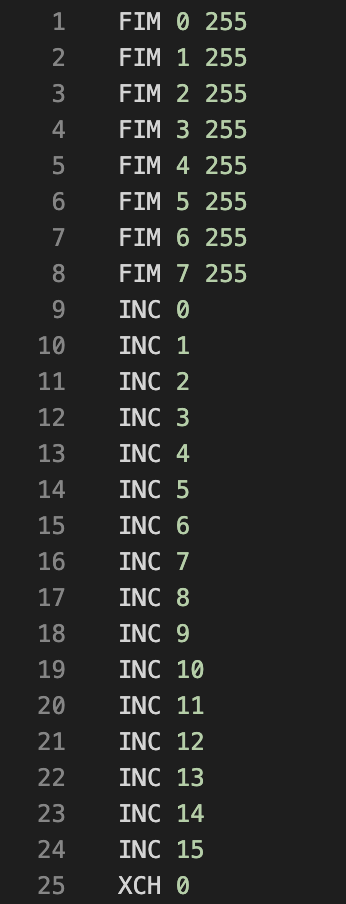Grasp all, lose all (La avaricia rompe el saco)

Although at first it seems to be an incomprehensible sequence of letters and numbers, it is not necessary to have extensive knowledge of computer science to understand it.
The Intel 4004 is a processor with 16 registers, numbered from 0 to 15, in which it is possible to store a maximum number of 4 bits. These registers can be accessed in pairs, the pair 0 being the one composed of registers 0 and 1; pair 1 is the one comprising registers 2 and 3, and so on. In the first eight lines, we see that the FIM instruction is used, which allows accessing these registers in pairs and assigning them a certain value. In this case, the FIM instruction 0 255, what it does is that registers 0 and 1 both acquire the value 15.
This is achieved because when we convert 255 from the decimal system to hexadecimal, we obtain FF. The letter F in hexadecimal is equivalent to 15 in decimal, so indicating the value 255 (or FF) makes both registers 0 and 1 acquire the value 15. After providing the maximum value to each of the pairs of registers, the next step is to increment the value of each of them by 1. To achieve this, the INC instruction is used. What this causes is a register overflow, causing the register to take the value 0.
Subsequently, the XCH instruction is responsible for passing the value of register 0, although the value of any of the registers could be used, to the accumulator. The accumulator’s function within the microprocessor is to store information temporarily, assuming an intermediate position between the registers and the memory. In this case, the accumulator ends up receiving the value 0, the same value it had at the beginning, although its registers have reached the maximum value.
The idea of accumulator extends its meaning in the world of computing to the one assigned to it generically in the dictionary: the one that accumulates. Although, in this case, the accumulated amount is reduced to zero as a consequence of the excessive sum made in the registers, literally applying the proverb that gives the composition its title.
Research conducted with a Banco Sabadell Foundation Grant for Research in Social Sciences and Humanities 2020-2021.